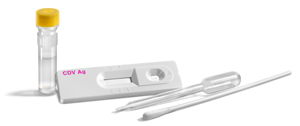Speed Distemper
Rapid detection of Canine Distemper Virus antigens
| Presentation | Advantages | |
|---|---|---|
|
Method: Membrane Immunochromatography Analysis: Assay for viral antigens of the Paramyxovirus that causes Distemper. Sample: Serum, plasma, urine, mucosal specimens (conjunctival, ocular, nasal, mouth) Preparation: 2 minutes Reading: 10 minutes Storage: 24 months at room temperature (2°C to 30°C) Presentation: 5 tests Reliability: In comparison with clinical diagnosis: |
|
| Why to use Speed Distemper ? |
|---|
|
Catarrhal inflammation of the respiratory and digestive tract can be followed by severe neurological sequelae or the death of the animal.
Antigen detection methods may be performed at puppies with colostral immunity, as they don't cross-react with antibodies deriving from maternal immunity. |
| When to use Speed Distemper ? |
|---|
|
Speed Distemper provides a specific detection of the Distemper virus, irrespectively of the age of the animal. In multi-animal environments, Speed Distemper can be used to protect healthy animals and identify rapidly virus excretors. Speed Distemper offersthe rapid and early detection of the disease, as from the end of the incubation period (3 to 7 days). |
Instructions for use
Bibliography:
(1) Etude interne BVT sur 121 animaux.
(2) THIRY E. La maladie de Carré. Virologie clinique du chien et du chat, 2002, Ed. Point Vétérinaire
(3) Enquête épidémiologique. Semaine Vétérinaire, 22 Janvier 2005, 1167
(4) PIERSON P. Conduite à tenir face à un épisode de diarrhée aiguë en élevage canin. Nouveau Praticien Vétérinaire, 2003, 14, 257-263


 The Distemper virus is transmitted via inhalation through direct contact with a carrier animal (2).
The Distemper virus is transmitted via inhalation through direct contact with a carrier animal (2).